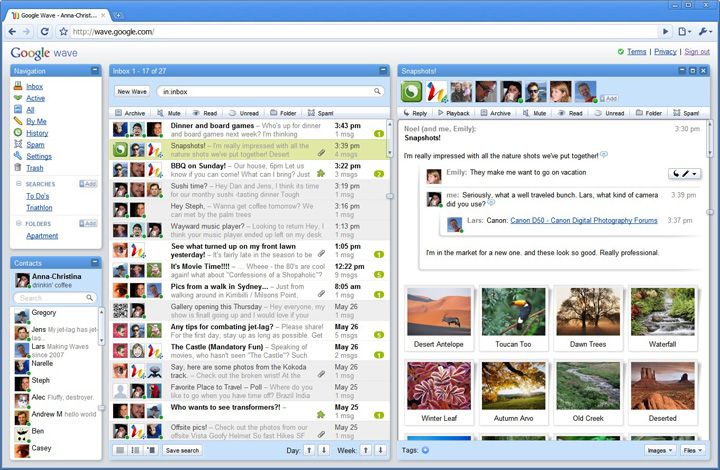It is described as a personal real-time communication & collabration tool.A wave can be both a conversation
and a document where people can discuss and work together using richly formatted text, photos, videos, maps,etc
 It is a web based service, i.e it can be embedded into webpages & other web based platforms,its a communication protocol for a new way of communication designed to merge e-mail, instant messaging, wikis, and social networking.
It is a web based service, i.e it can be embedded into webpages & other web based platforms,its a communication protocol for a new way of communication designed to merge e-mail, instant messaging, wikis, and social networking.Here's what the official Google Blog has to say about it:
Google Wave is designed as a new Internet communications platform. It is written inJava using OpenJDK and its web interface uses the Google Web Toolkit. Google Wave works like previous messaging systems such as email and Usenet, but instead of sending a message along with its entire thread of previous messages, or requiring all responses to be stored in each user's inbox for context, message documents (referred to as waves) that contain complete threads of multimedia messages (blips) are perpetually stored on a central server. Waves are shared with collaborators who can be added or removed from the wave at any point during a wave's existence.Waves, described by Google as "equal parts conversation and document", are hostedXML documents that allow seamless and low latency concurrent modifications. Any participant of a wave can reply anywhere within the message, edit any part of the wave, and add participants at any point in the process. Each edit/reply is a blip and users can reply to individual blips within waves. Recipients are notified of changes/replies in all waves in which they are active and, upon opening a wave, may review those changes in chronological order. In addition, waves are live. All replies/edits are visible in real-time, letter by letter, as they are typed by the other collaborators. Multiple participants may edit a single wave simultaneously in Google Wave. Thus, waves can function not only as e-mails and threaded conversations but also as aninstant messaging service when many participants are online at the same time. A wave may repeatedly shift roles between e-mail and instant messaging depending on the number of users editing it concurrently. The ability to show messages as they are typed can be disabled, similar to conventional instant messaging.[3]The ability to modify a wave at any location lets users create collaborative documents, edited in a manner akin to wikis. Waves can easily link to other waves. It is in many respects a more advanced forum. A wave can be read and known to exist by only one person, or by two or more. It can also be public, available for reading and writing to everyone on Wave.
The history of each wave is stored within it. Collaborators may use a playback feature in Google Wave to observe the order in which a wave was edited, blips that were added, and who was responsible for what in the wave.The history may also be searched by a user to view and/or modify specific changes, such as specific kinds of changes or messages from a single user.
No comments:
Post a Comment